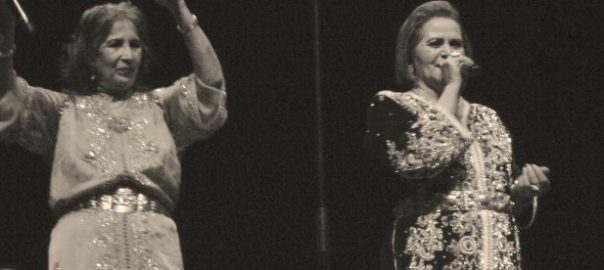Kisses, selfies and lots of wild wild women at the Matinée Marocaine in Muziekgebouw in Amsterdam. Khadija Margoum and Khadija El Bidaouia sang Moroccan songs about joy, suffering and love.
by Charlie Crooijmans
Amsterdam – Before the concert started, the documentary Aïta of film director Izza Genini was screened. The movie brought us back to 1988. Khadija El Bidaouia was one of the young women that traveled along with the Bedouin group of chikhates (female singers) and chioukhs (musicians). In the Q&A Genini explained that this music genre was popular among the people but had a low status. The women were traveling with men, smoked, drank, danced and waved their long hair. Women of loose morals. They ought to stay at home. But nowadays the music is considered respectful and important. This is mainly due to the efforts of Brahim El Mazned, director and founder of Visa for Music in Rabat among other festivals.
El Mazned compiled the price winning anthology Chikhates et Chioukhs de l’Aïta to preserve Moroccan musical legacy. He hopes that Aïta will become as strong as Flamenco in Spain, Fado in Portugal or Cumbia in Colombia.
It’s good to know that the performances in Amsterdam and l’Institut du Monde Arabe raised the interest of the media in Morocco, as well as in Europe. El Mazned is convinced that many more venues in other countries are interested because of the fact that this music was born feminine.
“At first, it was a rural expression of a feminine voice, and the musicians were all male. However, it has never been that exclusive. Starting in the 70s, more male voices sounding somehow feminine, started to show up.” says El Mazned.
In the Anthology, that has been distributed to all the universities, as well as in 350 libraries in Morocco, and around the world, you can learn about the different schools within the genre. Khadija Margoum and Khadija El Bidaouia for example come from two different Aïta schools: Margoum from Hasbaoui (Safi region) and El Bidaouia from Marsaoui (Casablanca region).
“The music is still used in the traditional way and it has a huge social role. It is performed in wedding parties, in cabarets, and in traditional events such as Moussem (an annual pilgrimage in honor of the local saint, cc).” But El Mazned is also very glad that a new generation is inspired to create a more modern version, using Aïta as a source of inspiration.
For El Mazned it is important to show this kind of music in the Netherlands, because the immigration of Moroccan people in Holland had begun 50 years ago. “Those immigrants becoming Holland citizens have a double culture. It is very important to maintain this double identity. But Holland has always been a well known country that is open to the cultures of the world, and I think that it is essential to keep that openness going through the generations and the years.”
El Mazned tries to keep this art alive that gathers all the social classes and to highlight its potential and social power. “Aïta is important to us because it talks about the actual history of each region in Morocco, with some details of some historical events, but also more common facts such as the daily life of the people of that time. It is also the link between the rural and the urban areas, all with cohesion. It is a music admired by both rural people and by the elite.”
For the women in the audience Aïta is an expression of freedom, Moroccan identity and togetherness. It was an exhilarating afternoon!
